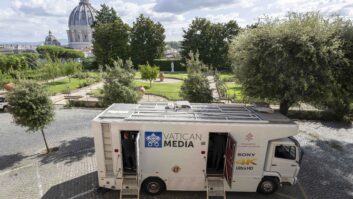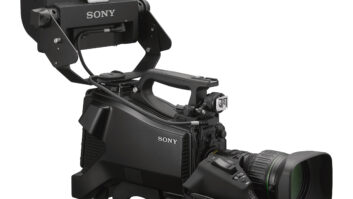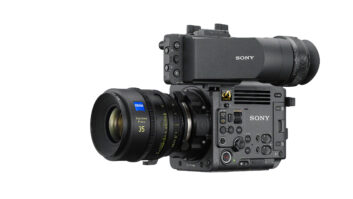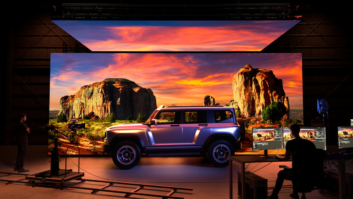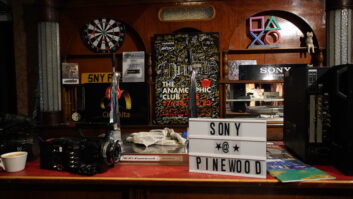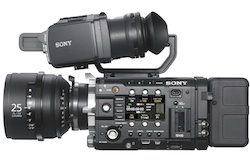
Live trials at three football matches during the FIFA Confederations Cup this June will be used by Sony and FIFA to inform the extent of 4K production and possible broadcast from Brazil at next year’s World Cup. Among Sony’s priorities will be the focus management of its F55 cameras, which were designed for digital cinema not live outside broadcast. The finishing touches are being put to the HD/4K scanner being built by Sony for outside broadcast supplier Telegenic ahead of its transport to Belo Horizonte, one of the venues for the Confederations Cup, which starts June 16. Signals will be routed around the truck in Quad Full HD, or four streams of HD-SDI at 60p. A key part of the equipment needed to be adapted to these bonded HD signals is the vision mixer. In the truck, Sony’s MVS 8000x switcher will be tested prior to a software update later this year that will free up more of the system’s capabilities. “Right now we are able to perform certain functions, such as simple mixes and wipes, but we need new software which will enable the system to understand that it is receiving four HD quadrants and to manage those so that it outputs one bonded 4K image,” explained Mark Grinyer, Sony’s head of business development for 3D & 4K and programme manager World Cup 2014. On board the truck will be six PMW-F55 cameras streaming raw 4K into BPU-4000 Base Band Processor Units, which in turn output four HD-SDI streams and a separate down-converted HD output. A transmission camera adaptor attached to the F55 (a CA-4000) provides familiar CCU operation and talkback to the operator. Recording is being made to SR-R1000 storage units that can handle two streams of 4K (totalling 8x HD) or one record and one replay. Equipped with multi-codec support, the F55 includes Sony’s new XAVC MPEG-4 AVC/H.264 format, the SR codec (MPEG4 SStP) and the industry-standard high definition codec 4:2:2 XDCAM at 50 Mbps. The internal recording uses the SxS Pro+, Sony’s new SxS support, which can be used to record XAVC HD content with a high frame rate and 4K at up to 60fps. In terms of full replay, Sony is working with EVS to test the 4K capability of multiple EVS slo-motion systems ganged together, and also production workflows controlled by EVS IP Director for ingest, metadata management, on the fly editing and playout. One of the key things under test are the lenses. These include a prototype lens convertor that permits standard 2/3-inch box lenses to be used with the F55’s Super 35mm sensor; and new 4K Fujinon Cabrio lenses, including the Premier PL 14-28mm Cabrio wide angle. Under examination is whether the F55’s Super 35mm 4K single CMOS sensor is appropriate for live sport. These produce a shallow depth of field, not normally an issue with 3x 2/3-inch sensors associated with OB, but a defining characteristic of cameras like the F55 CineAlta that were designed for high end drama and commercials. “The question becomes – if it works well and people like the price point [£22,000] and the director likes the images it creates – then do we need specific 2/3-inch cameras?” asks Grinyer. “The cost of building a new 4K three-chip camera is a serious discussion point. The F55 offers advantages such as high speed shooting and the ability to shoot both 4K and HD simultaneously, so it will be interesting to receive feedback.” He added: “With the higher pixel count of 4K for display on larger screens then focus becomes more critical. In some instances, the shot becomes quite narrow so it’s a matter of balance between lens and camera and focus and finding what works. It’s also a matter for production. Does production like the look?” In Brazil, Sony will experiment with putting 4K cameras in traditional broadcast positions and work out how those cameras could be used to complement the 34-camera per match HD production planned for the World Cup 2014. “Just repeating HD match coverage in a higher resolution may not be what gets the consumer excited,” he suggested. “What might, though, is using 4K in a different style – using the extra light (dynamic range), or higher frame rates, or new depth of field for certain shots.” Grinyer cites the lowdown diagonal shots in tennis coverage, something that Sony will be testing at Wimbledon this year. “Given the higher resolution and viewing on larger screens, could a director use fewer 4K cameras for a 4K production? Could we augment 4K with HD cameras and upscale those to 4K? Could we place two F55s side by side in the Camera One (high gantry) position and stitch their pictures together into 4K and produce HD feeds from that?” The tests will be used to inform the extent of 4K production and possible broadcast from Brazil at next year’s World Cup. To large extent Sony’s hands are tied between broadcasters willing to take 4K content and the development of core pieces of equipment necessary for it to be transmitted. FIFA is assessing demand among its rights holders for both a 3D and a 4K feed from Brazil 2014. Parties most interested include broadcasters in South Korea, Japan and in the US where Univision (Spanish language cable network) and ESPN hold rights. In the UK, 2014 World Cup rights are shared between ITV and the BBC. One wonders if they could be persuaded to work with Sky Sports to air a 4K World Cup Final? Technically, however, the live 4K signal would need to be compressed for satellite delivery in the Higher Efficiency Video Coding scheme, something which is not yet possible. New silicon would have to be developed and then incorporated into new set top boxes for rendering the HEVC signal in the home. In addition a new HDMI interface capable of transferring uncompressed 4K between devices needs to be agreed. Expected for release at the end of 2012, the new HDMI 2.0 specification is still not ratified, though anticipated soon. Sony does not rule out Ultra-HD transmission of matches from Brazil 2014 to cinemas. The trials at the Estadio Mineiro will be directed by Ben Miller, the senior producer of 3D coverage for Sony and FIFA during the World Cup 2010. Adrian Pennington www.pro.sony.eu
